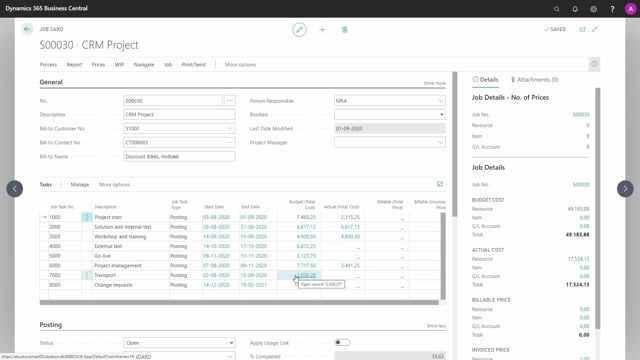
What is the bottom level of the job hierarchy?
So, I often find that this third level of the job hierarchy is what most people have trouble understanding. It’s not hard to understand when you see the model here and the division into job planning lines and job ledger entries. But the actual work with the entries in the system can be a bit confusing when you start using this module.
This is what happens in the video
It’s very important to understand the difference between planning lines and job ledger entries, and what they’re used for.
A good way to see this is not the level gives us details on how far we are on the project, by defining the expected and tracking the actuals. And that’s why we need both planning lines and job ledger entries.
As I mentioned the job planning lines show the expected for each job task. The planning lines describe the expected consumption of items, of resources, and other costs.
For example, which resources should do what work? Which items do we need? And the different types of planning lines can help us define whether the plan consumption should be invoiced or not.
On the other hand, the job ledger entries show the actuals.
So, what we have actually realized on this job; they can be divided into sales entries, and usage entries post to this job.
If we look at this from another perspective, we have the project in the middle, on the left side my model we have time registration, purchase invoices, and so on.
So that’s our consumption. On the right side I have sales invoices. So that’s what we are actually selling to the customer and invoicing to the customer.
The planning lines can be budget or billable. If we have the type budget it’s to track what we expect on the consumption side. If we had the type billable, this is what will be billed on the sales invoice to the customer. We can also have the combination of the two, where the budget and the billable are equal. For example, if we’re billing time and material.
The job ledger entries can be of type usage or sale; the usage is our consumption and the sale are what has actually been invoiced to the customer.
Depending on whether we’re using the usage link functionality, the direct link between planning lines and job ledger entries is more or less clear. There’s another video on that.
As I mentioned the planning lines can be of type budget, or billable, or both budget and billable.
And the difference between these is very important to understand, sometimes I have customers who don’t understand why they’re not able to create a sales invoice.
And then when I look, it’s because they’ve only created budget planning lines, because as the name says, budget planning lines are used for the expected cost on the job.
The billable version shows us the expected sales and these are the lines which I invoiced.
It’s good to have the division of budget and billable in two separate types if we’re for example invoicing a fixed price to the customer, but if we’re invoicing time and material, we can use the both budget and billable.
This way expected usage and the sales are equal to one another.
I would recommend that you watch the video regarding usage link where we decided that should be a traceable link between job planning lines and job ledger entries.
For each type of job planning line; we can plan on resources, items, or directly on the G/L account level.
Each job tasks line in the second level can have multiple related job planning lines, the same goes for job ledger entries of course, so there can be several job ledger entries related to each job task, and they will increase over time as we post with job journals or invoices.
The job ledger entries have two types.
The sale is the actual sales related to this job so what we have invoiced, and the usage is the usage of items, resources, and costs.
Let’s just have a quick look in the system. I will go to the list of jobs. And I will open one of the projects. So, the job card is my Level 1, the tasks here are Level 2, and then the sums here. I see the numbers from my planning lines, and job ledger entries. I can see that I have budget total cost and actual total cost. So, if we compare my budget of 7460. It’s based on the range of planning lines, they’re planned on different resources. Summing to the amount I saw. The actual cost is based on job ledger entries of the type usage.
So far, there’s been no billing on this job. And I can also see that if I go to job ledger entries to get the full list across job tasks numbers, It’s only the type usage, if I had made a sales invoice from this job.
We would in this list be able to see the type sale.
This division into budgets and actuals is what we can use to follow up on the progress of this job.
And if I go back to my model, we can see that I can compare billable to sale, to see how far we are with the invoicing, and I can compare my budget to the usage to see how the forecast actually match the reality, and the fact that we can calculate work in progress, which gives us the value proposition for using jobs, as you cannot do this in other parts of the system.

